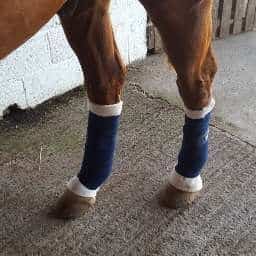Wingalls or Windpuffs as they are known Stateside, are soft fluid filled swellings at the base of the tendons, just behind and above the fetlock joint. They are most commonly seen on the hind legs of the horse, but can be present in all four limbs. They tend to be more common in heavier horses and cobs, but can occur in all horses that have been doing a lot of intense work on hard ground or when too much work is asked of a young horse before they are physically capable.

There are two types of Windgalls; Articular Windgalls those pertaining to the Fetlock Joint and Tendinous Windgalls, those pertaining to the Digital Flexor Tendon Sheath. Windgalls are often no cause for concern and are just seen as a blemish particularly when they are seen equally on a pair of limbs and there is no heat or lameness involved. However, it is always better to investigate their cause particularly if they are a recent development on your horse, to ensure that they are not a symptom of a more serious problem.
Types of Windgalls;
Articular Windgalls
The Articular Windgall occur when the Fetlock joint has been over stressed, and there has been some stretching to the Fetlock Joint Capsule resulting in distension of the capsule and extra synovial swelling occurring at the back of the fetlock joint. This may be accompanied by heat and lameness depending on the severity of the injury and should be assessed by the vet at the earliest onset to determine the best course of treatment for the horse.
As with any joint injury, a period of rest and rehabilitation is key to ensuring that the horse will be able to return to normal work.

Tendinous Windgalls
The Tendinous Windgalls occur when there is an excess of Synovial Fluid production in the Digital Flexor Tendon Sheath. This sheath is lined with a synovial membrane and functions to provide smooth movement for the flexor tendons that run down the back of the cannon bone. It has been found that injury to one or both of the flexor tendons can produce local inflammation in the area therefore reducing the smooth movement of the tendons within the DFTS. This causes friction between the tendons and therefore an increase in the production of synovial fluid within the sheath that is seen as a puffiness, i.e. the windgall, normally at the base of the tendons just behind and above the fetlock joint. This type of windgall can be accompanied by heat and lameness and should be investigated by your vet at the earliest convenience to prevent irreparable damage.
Symptoms of Windgalls
As previously stated Windgalls are usually seen as a puffiness at the base of the tendons at the back of the limb just above the Fetlock Joint. They are normally symmetrical on a pair of limbs. They can be accompanied by heat and lameness and should be investigated by a Vet to determine the underlying cause.
Causes of Windgalls
Windgalls tend to caused by a lot of heavy work on hard ground. They can be seen more often in a heavier type of horse, or on older horses that have been doing a lot of jumping. Occasionally overwork of a young horse can be a contributory factor, as can poor conformation and imbalance in the hoof. All of the above can lead to damage of either the flexor tendons or the fetlock joint, giving rise to the development of Windgalls.

Treatment of Windgalls
In the case of acute injury, accompanied by heat and lameness, it is best to have your vet assess the horse as soon as possible. In an effort to determine the cause of the Windgall the Vet may recommend X-Ray or an Ultrasound Scan.
Then depending on the severity of the injury, there will be a period of rest and early treatment will involve cold hosing, poulticing and support bandages and anti-inflammatories may also be required. Controlled exercise/Box Rest is often crucial in the early stages of injury and there will be a period of rehabilitation prior to returning to work.
If the Windgalls are symmetrical and are not causing the animal any pain or discomfort and are not affecting its working life, then no treatment is required. Some people prefer to bandage the horse when in the stable as this controls the swelling when the horse is standing in.

Prevention
Horses that have an active sporting life often have mild Windgalls that are symmetrical and usually of the Tendinous variety, these cause the animal no problem and have no negative effect on its working life. This type of windgall is seen more as a blemish and often will reduce with exercise and be more pronounced when the horse is stabled.
The main thing to remember to reduce the incidence of Windgalls is to have a proper fittening program for the young horse and avoid over work. Also it is best to reduce too much work on hard ground. Regular visits from the farrier will prevent the feet from becoming over long, which would put unnecessary stress on the flexor tendons and fetlock joint during work, which could lead to injury.
Conclusion
The one thing to keep in mind with horses, is that Prevention is Better than Cure, have a steady fittening program for your horse, avoid over working your horse particularly on hard ground. Regular Visits from the Farrier will help to keep your horses feet balanced and remember it is good practice to always check your horses legs after exercise to pick up on the earliest sign that there may be a problem.
This article was originally published in the October 2020 Issue of Irish Sport Horse Magazine.
